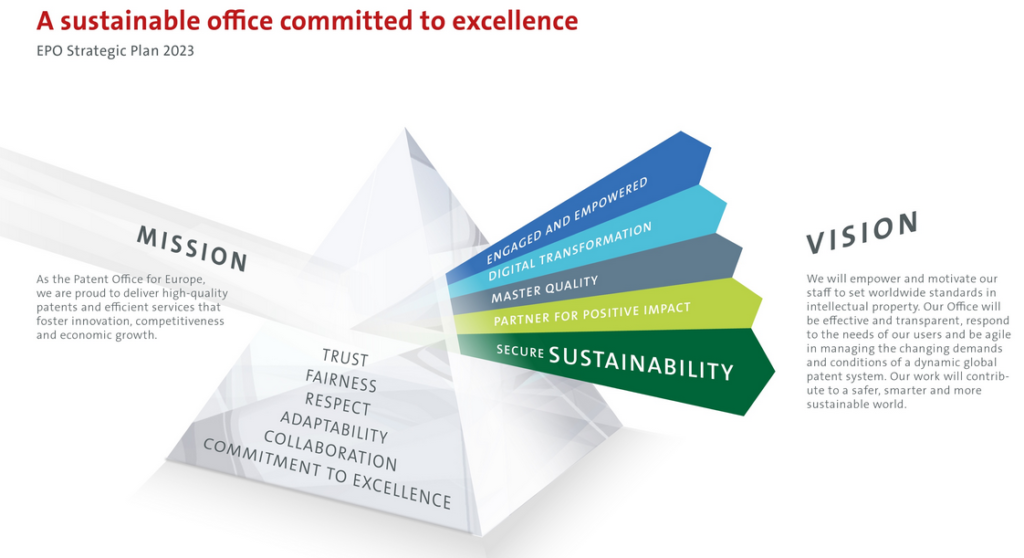A vision of sustainability: European Patent Office publishes Strategic Plan 2023
The European Patent Office (EPO) has set out an ambitious vision to excel in its role as one of the world’s foremost intellectual property offices.
The EPO’s Strategic Plan (SP2023), unanimously adopted yesterday by its Administrative Council, focuses on achieving five goals that will ensure the EPO is capable of delivering excellence to all its stakeholders.
Staff engagement, a modern IT infrastructure, quality products and services and a high- impact European patent network have all been targeted as strategic objectives that will help the organisation to achieve its fifth and ultimate goal of future sustainability. Each goal features several key initiatives that will be implemented over the next four years, with some projects expected to extend beyond the duration of the current plan.
SP2023 was developed in consultation with the EPO’s 38 member states, patent system users, the public, national intellectual property (IP) offices and EPO staff in two rounds of consultation to ensure that the Office’s priorities strike a balance between all its stakeholders’ needs.
« This Strategic Plan is a clear vision of how we want our Office to look in the future, and how we plan to achieve it, » said EPO President António Campinos. « What we have now is a roadmap for achieving a more sustainable patent office for Europe, better equipped to succeed in an evolving IP landscape. We intend to be a more adaptable and agile organisation that can support inventors everywhere with improved and more responsive services. This may be ambitious, but with the commitment and expertise of our staff, we also believe that it is achievable. »

New challenges, a new direction
Since its creation some 40 years ago, the EPO has built its reputation on providing high- quality products and services that are recognised globally: timely delivery of the patent grant procedure, thorough novelty searches, and predictable outcomes of the examination on patentability, as well as fair review procedures of its decisions.
The Strategic Plan was developed against the backdrop of rising demand for patent protection in Europe. Over 174 000 applications were filed at the EPO in 2018 and this figure is expected to grow at an annual rate of 3-4%. There is also clear evidence of the growing economic importance of IP protection. Within the EU, industries that make intensive use of IP rights such as patents, trade marks and registered designs account for some 38% of jobs, 42% of GDP and 90% of external trade. A recent study published by the EPO and EUIPO also showed that SMEs using European patents or bundles of IP rights are more likely to experience high growth.

However, the combination of an increasingly networked and globalised world economy, new players in the patent system, evolving stakeholder expectations and rapid technological change mean that the EPO faces complex new challenges. SP2023 is a roadmap that will help the EPO to rise to these challenges and make sustainable advances.
The Strategic Plan identifies five areas:
- Build an engaged, knowledgeable and collaborative organisation: SP2023 looks at several areas that will help staff to realise their full professional potential. Beyond staff retention measures, the EPO will continue to identify, attract and recruit talent in key areas.
- Simplify and modernise EPO IT systems: the plan outlines several initiatives for simplifying and modernising the EPO’s IT system. These include a single tool to support an end-to-end electronic patent granting process. In response to rising volumes of patent literature worldwide and the growing technical complexity of inventions, the EPO will continue to invest in prior art databases, with a special focus on Asian documentation and standards.
- Deliver high quality products and services efficiently: SP2023 provides for a number of new initiatives that aim to secure the recognised high standard of EPO products and services. These include a user-agreed definition of quality, as well as offering a more flexible patent grant process.
- Build a European patent system and network with a global impact: co-operation with the national patent offices of the member states and international partners will be strengthened. The EPO will review the financial and operational support that it offers to encourage greater participation, ensure cost-efficient and timely delivery, and maximise the impact of co-operation activities.
- Secure long-term sustainability: the initiatives set out in the plan will ensure that the EPO remains sustainable on a long-term basis. They include the creation of an Observatory, a platform that will bring together public and private stakeholders to discuss and debate developments in innovation. Through analyses and studies, the Observatory will provide a more accurate understanding of trends and technologies, allowing effective decisions to be taken. SP2023 also considers the EPO’s environmental impact and sets clear targets for reducing its carbon footprint, lowering energy and paper consumption and eliminating plastics.
Drafting SP2023: a collaborative effort
It took several months to draft SP2023, as it incorporated broad-based feedback from a variety of sources. Members of the general public were invited to submit comments in an online consultation on specific topics, and the EPO’s member states shared their views on challenges facing the patent system and how to foster co-operation with the EPO. Additionally, some 100 user groups and other bodies such as SACEPO (Standing Advisory Committee before the EPO) shared their strategic vision and views on enhanced collaboration. EPO staff members were also invited to comment on SP2023 both online and in face-to-face meetings with President Campinos. Two rounds of consultation produced a plan that provides a clear roadmap for achieving the shared vision expressed in the five main goals.
To read the full plan, please visit
About the EPO
With nearly 7 000 staff, the European Patent Office (EPO) is one of the largest public service institutions in Europe. Headquartered in Munich with offices in Berlin, Brussels, The Hague and Vienna, the EPO was founded with the aim of strengthening co-operation on patents in Europe. Through the EPO’s centralised patent granting procedure, inventors are able to obtain high-quality patent protection in up to 44 countries, covering a market of some 700 million people. The EPO is also the world’s leading authority in patent information and patent searching.



